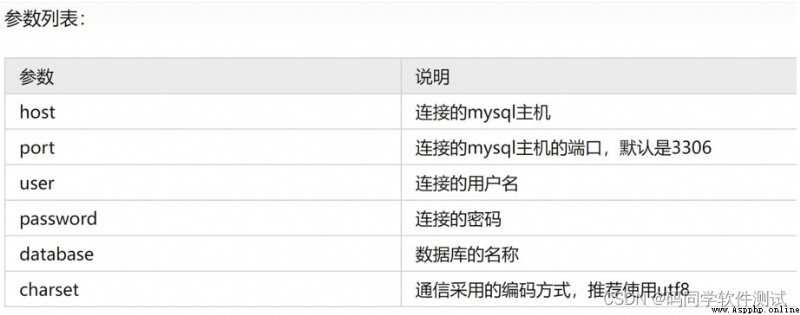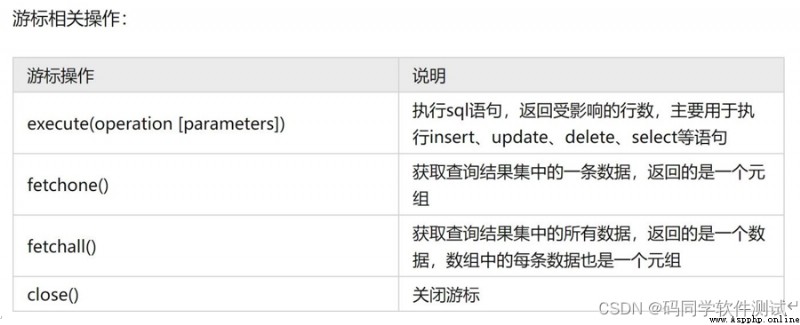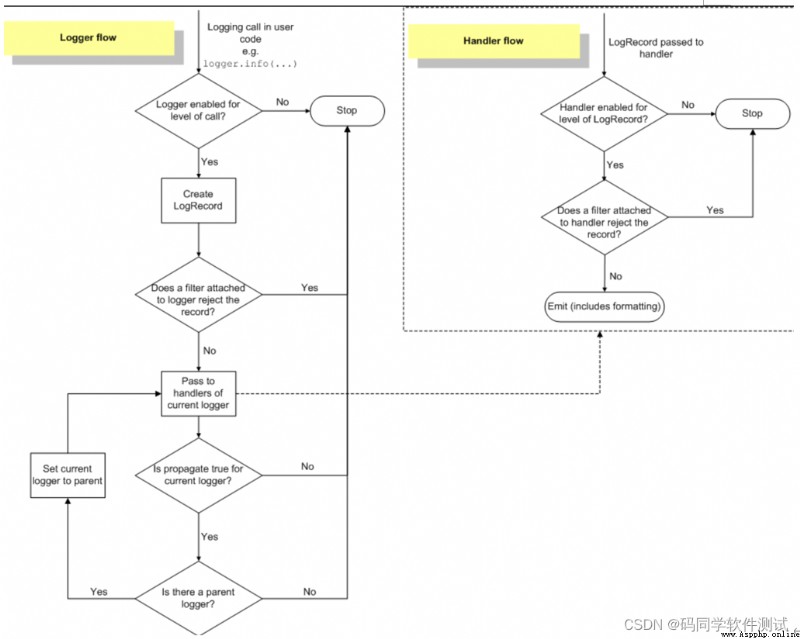When carrying out interface test , We need to connect to the database , Back up the data source 、 Restore 、 Verification and other operations .
Python Common modules for connecting to databases
MysqlDB
python2 The hottest driver library of the times . be based on C Development , Yes windows Platform unfriendly . Now it has entered python3 Time , Basically no longer use
MysqlClient
It is a heavyweight Web Development framework Django in ORM Function dependent tools
Pymysql
pure Python The driver of implementation , Performance ratio MysqlDb Bad , But the installation is simple , Easy to use
SQLAlchemy
That is, it supports native SQL Also support ORM The library of
We use pymysql For example
01
Pymysql Usage method
Installation method :pip install pymysql
Pymsyql Usage flow
Get the connection
To obtain the cursor -- The function of cursor is to traverse the records returned by query database , In order to carry out the corresponding operation
perform SQL sentence
Close cursor
Close the connection


Code implementation :
connect =
pymysql.Connect(
host='xxxxx',
port=3306,
user='root',
password='XXXX',
charset='utf8mb4',
cursorclass=pymysql.cursors.DictCursor
)
connect: receive Pymysql.connect Object returned by method , Establish connection object
pymysql.Connect Establish connection method
host=XXXX Connect to the database server
port=3306 Connection database port number
password=“xxxxx”: password
charset=“utf8mb4”: The code for establishing the connection
cursorclass=pymysql.cursors.DictCursor: Set the return data type Return dictionary
cursor = conn.cursor()
cursor.close()
conn.close()
Query order Library
Get a cursor object
cursor = connect.cursor()
Query database name plus table name
mtxshop_trade.es_order
cursor.execute(“SELECT order_id,trade_sn FROM mtxshop_trade.es_order WHERE order_id=47050 OR order_id=47049”)
data = cursor.fetchall() # Get all the results of the query
cursor.close()# Close cursor object
02
The basic concept of log
Mention log , Whether it's writing framework code or business code , Are inseparable from the log records , He can bring us great help in locating the problem , The best practice is to use built-in logging modular , because logging The module provides developers with very rich functions .
The level of logging
The log level is used to control the information level of the printed log
First , When configuring the log module , You need to set the log level of the log module first
for example , If set to INFO Level , Then print the log with DEBUG The log will not be output .
DEBUG
INFO
WARNING
ERROR
CRITICAL
Log output mode
Output to console
output to a file
Log format
Specify the format and content of the output log. Common formats are :
%(levelno)s: Print log level values
%(levelname)s: Print log level name
%(pathname)s: Print the path of the currently executing program , In fact, that is sys.argv[0]
%(filename)s: Print the name of the currently executing program
%(funcName)s: Print the current function of the log
%(lineno)d: Print the current line number of the log
%(asctime)s: Time to print the log
%(thread)d: Print thread ID
%(threadName)s: Print thread name
%(process)d: Printing process ID
%(message)s: Print log information
logging Usage flow
First step : Instantiation logging modular
The second step : Set log level
The third step : Configure the log processor 、 Log format ; Log processor : Control the printing mode of the log
Step four : Print log
01
logging Module processing flow

The interface test framework implements the log collection function
Write the log configuration function code
This function configures the output log to the console and file , And set the log printing format
def logging_init():
logger = logging.getLogger()
logger.setLevel(logging.INFO)
stream_handler = logging.StreamHandler()
file_handler = logging.handlers.TimedRotatingFileHandler(config.BASE_DIR + “/logs/lagou_log.log”, when=‘h’,
interval=1,backupCount=3, encoding=“utf-8”)
fmt = "%(asctime)s %(levelname)s [%(name)s] [ %(filename)s %(funcName)s % (lineno)d ] %(message)s "
formatter = logging.Formatter(fmt)
stream_handler.setFormatter(formatter)
file_handler.setFormatter(formatter)
logger.addHandler(stream_handler)
logger.addHandler(file_handler)
return logger
And then in api. init .py This function is called , Complete the initialization of the log
from utils import logging_init
logging_init()
import logging
logging.debug(“ test debug Level of log printing ”) # Don't print
stay api. init .py Reason for initializing log configuration :
execute perform script Use case in ,script The use case in is to call api Interface implementation interface testing , Follow the module syntax , When calling a module , It will automatically execute the... Under the module init .py Code
follow-up , Only need to print the log in the module , Import logging Installation package , You can output the log information of the configured log format and log level

 Analysis of level 2 real questions (multiple choice questions) of Python programming level test for youth software programming of Electronic Society March 2021
Analysis of level 2 real questions (multiple choice questions) of Python programming level test for youth software programming of Electronic Society March 2021
2021 year 3 month Python Analy